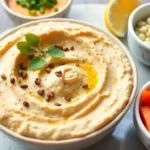World Recipes Falafel Guide

- Understanding Falafel: A Delicious Middle Eastern Classic
- Ingredients for Homemade Falafel (Serves 4-6)
- Step-by-Step Preparation of Falafel
- Serving Suggestions: Enjoying Falafel in Various Ways
- Exploring Variations: Different Takes on Falafel
- Falafel in Popular Culture: A Global Sensation
- Conclusion: Embracing the Falafel Experience
Falafel, a beloved dish with roots in the rich culinary traditions of the Middle East, has become a staple in vegetarian and vegan diets around the world. If you have ever experienced the delight of biting into a crispy, golden falafel ball, you know just how satisfying this dish can be. With its versatility and affordability, falafel can be enjoyed as a main course or as a delightful snack. Let’s dive deeper into the world of falafel, exploring its origins, variations, and how to prepare it perfectly at home.
Understanding Falafel: A Delicious Middle Eastern Classic
Falafel is often regarded as a quintessential Middle Eastern dish, primarily made from ground chickpeas or fava beans, combined with herbs and spices. Its history traces back to ancient Egypt, where it was likely consumed by the poor as a cheap source of protein. Today, falafel is enjoyed globally, celebrated for its deep flavors and satisfying crunch.
This dish can be served in numerous ways, often accompanied by pita bread, fresh vegetables, and a variety of sauces. The beauty of falafel lies in its adaptability; it can be served as a sandwich, in a salad, or simply on its own as a snack.
Ingredients for Homemade Falafel (Serves 4-6)
For the Falafel
- ½ kg canned chickpeas (drained)
- 2 onions, finely chopped
- 2 cloves of garlic
- 1 cup breadcrumbs
- A generous handful of parsley
- A generous handful of cilantro (or mint, if preferred)
- 2 teaspoons cumin
- 1 teaspoon salt
- 1 teaspoon baking powder
- A pinch of pepper
- Oil for frying
For the Sauce
- Natural yogurt
- A handful of mint leaves
- 1 clove of garlic
Step-by-Step Preparation of Falafel
Creating your own falafel at home is not only rewarding but also allows you to customize the flavors to your liking. Here’s how to do it:
- Using a food processor, blend the chickpeas with breadcrumbs, parsley, cilantro (or mint), onions, and garlic until you achieve a coarse mixture. If it’s too thick, add a bit of warm water.
- Incorporate the salt, pepper, cumin, and baking powder into the mixture.
- Let the mixture rest for about 30-45 minutes; this helps the flavors meld together.
- Shape the mixture into balls or small patties. If the mixture is too wet, you can add more breadcrumbs to achieve the right consistency.
- Heat oil in a pan and fry the falafel balls until they are golden brown and crispy on the outside.
- For the mint sauce, simply blend the yogurt, mint leaves, and garlic together until smooth.
- Serve your delicious falafel warm with the mint sauce on the side!
Serving Suggestions: Enjoying Falafel in Various Ways
Falafel can be enjoyed in countless ways, making it a versatile dish for any meal. Here are some popular serving ideas:
- As a sandwich: Stuff falafel balls into pita bread with fresh vegetables like lettuce, tomatoes, and cucumbers.
- In a salad: Toss falafel with greens, cherry tomatoes, and a tahini dressing for a nutritious meal.
- As a snack: Serve falafel with dipping sauces such as tahini, garlic sauce, or spicy harissa.
- In a bowl: Create a falafel bowl with quinoa or rice, topped with roasted vegetables and a drizzle of your favorite sauce.
Exploring Variations: Different Takes on Falafel
While the classic falafel is made with chickpeas, there are numerous regional variations that highlight local ingredients and flavors:
- Egyptian Falafel: Traditionally made with fava beans, Egyptian falafel has a unique flavor and texture.
- Lebanese Falafel: Often spiced with more herbs, Lebanese falafel is known for its fragrant and aromatic profile.
- Sri Lankan Falafel: Incorporating local spices and herbs, this variation offers a unique twist on the classic recipe.
Falafel in Popular Culture: A Global Sensation
In recent years, falafel has gained immense popularity beyond its Middle Eastern origins, becoming a favorite among foodies and health enthusiasts alike. Its rise can be attributed to several factors:
- **Vegan and Vegetarian Appeal:** With the growing trend of plant-based diets, falafel serves as an excellent protein source for those avoiding meat.
- **Street Food Phenomenon:** Many cities around the world now boast falafel stands, offering quick and delicious meal options.
- **Health Consciousness:** Falafel is often deep-fried, but it can also be baked or air-fried for a healthier alternative, appealing to those seeking light meal options.
For those interested in perfecting their falafel-making skills, this video presents an excellent tutorial on preparing crispy falafel from scratch:
Conclusion: Embracing the Falafel Experience
Ultimately, falafel is more than just food; it represents a cultural experience that transcends geographic boundaries. Whether you're enjoying it at a bustling market in Cairo or whipping it up in your own kitchen, falafel has a way of bringing people together. So, gather your ingredients, invite friends over, and savor the delightful flavors of this Middle Eastern classic.





Deja una respuesta